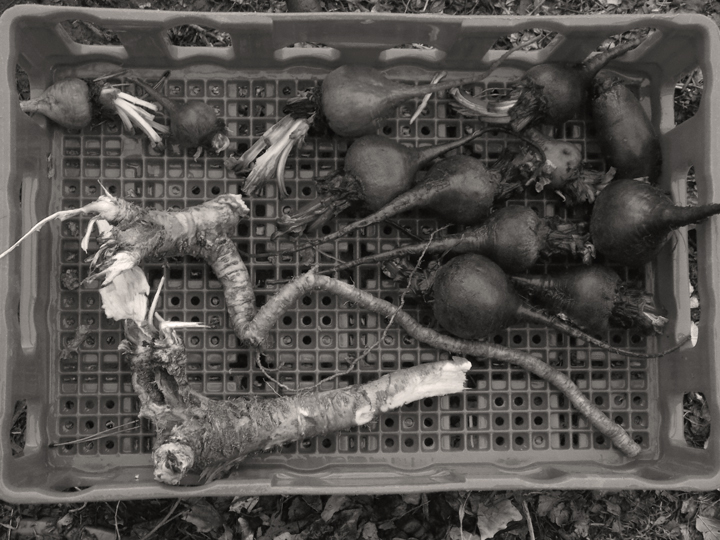“Cold dark deep and absolutely clear,” from “At the Fishhouses” by Elizabeth Bishop
“[R]emember that it is not you that support the root, but the root that supports you.” St. Paul in a letter to the Romans, 11:18b
Apart from a couple experiments with greens in the greenhouse and hoophouse (a smaller, portable greenhouse), most of the fresh vegetables available now are roots.
We are ordinarily up to our ears by now in potatoes – yellows, reds, and purples – with the purples lasting longest and the reds the first to go soft. But this year is different: our storage potatoes are more green than yellow because I left them to cure too long in the sun. So my mistake has sent me seeking other roots.
Beets are always in abundance in the garden. I don’t particularly enjoy them – not boiled anyway – but they thrive in our clay soils. Sugar beets put this region on the map. And they keep well buried in moist sand. Last year I forgot about a bucket, and in March, when I found it, several of the roots were perfectly firm.
Then a couple weeks ago I found a horseradish patch on the farm that I had only heard tales of, but never seen. Some good soul planted it before my time, and the plants survived despite human neglect and drought conditions. Like beets, horseradish seems to be another root that thrives here.
I had both these roots on the brain when I came across an old cookbook compiled by a committee of Russian Orthodox ladies. It was my wife’s great aunt’s book. Inside I discovered a recipe for Hrin, which is basically a horseradish and beet salad (recipe below).
Preparing this dish is like preparing for a punch in the face, or an autopsy.
Take horseradish. I pry a handful of crooked taproots from the dry ground, wash them, and take a peeler to the skin. I am immediately assaulted. This is a root from the ground — how can any soil abide something so offensive, burning as it does? Other roots, like the carrot, smell earthy and sweet. But this – it’s as though some ancient god slew a comet, buried it in the ground, and left us this seething root.
If horseradish offends, the beet is a horror. I hold in my hand nothing short of the earth’s own red heart. Once boiled, the beet’s cellular structure is broken down, creating a kind of hemorrhaging wherever it is cut, pierced, or grated. Rivers of red, like a plague. (A chef friend refuses to cook with red beets. Too gory, he says.) To make matters worse, beet juice stains hands, sealing your culpability in this bloody mess.
We underestimate roots. Oh we love our foliage, florets, and fruit, just like we love our light and heat. Ripe tomatoes, great big heads of lettuce and broccoli, sweet corn, sweet peas, sweet peppers… Meanwhile in the cold dark deep – underground where the dead rot – roots grow down and tubers bulge like tumors.
If we attend to roots properly, they may appall us. If they do, it may be that our own sensibilities are the problem.
We humans are not well enough acquainted with cold weather and darkness. I am all for heat – I write this as I sit next to my wood stove – but we seem obsessed with a room above seventy degrees. We abhor the cold – we named our most common virus after it. We treat it like an enemy. But I like warming up a room and warming up with it. I like warming as I work outside on a cold day. Cold can be a strange gift; in it we can learn to be peaceable, to live simply in our places.
As for darkness, we have become very good at ignoring it almost entirely. At this latitude, this time of year, the sun sets at around 4:00 P.M., and rises a little before 7:00 A.M. That’s about 15 hours of darkness, but the lights in most houses turn off the same time they always turn off. We seem to be working, distracted in front of a screen, or asleep. Darkness is simply the absence of light.
But if it has value for the root, perhaps it has value for our souls – sitting outside on a dark night, or in your dimly lit living room. Buried thoughts rise to the surface. Ideas. Questions. Quiet prayers.
In this season let us attend to roots – the strange fruit of the cold dark deep. Let it remind us that our own souls are hidden, buried, but nevertheless pulsing with pungency and meaning.
Hrin
Hrin is a Slavic dish. This recipe is from Agnes Kohan, exactly as it appears in Traditional and Favorite Recipes compiled by the Mother’s Club of St. Mary’s Russian Orthodox Church, Minneapolis, Minnesota, 1975. My wife enjoyed it, noting that it tastes better after a day in the fridge. I think it’s too salty, and I just don’t enjoy boiled beets.
Course: Salad
Cuisine: Slavic
Main Ingredient: Beets
Serves:
Ingredients
- 6 medium red beets if you are the queasy type, use yellow beets or Chioggia
- 1 cup freshly grated horseradish try to find it in root-form
- 2 T salt
- 1⁄3 c. sugar
- 1⁄4 c. apple cider vinegar
Directions
- Boil beets.
- Remove skins.
- Grate.
- Add other ingredients.
- Combine.






